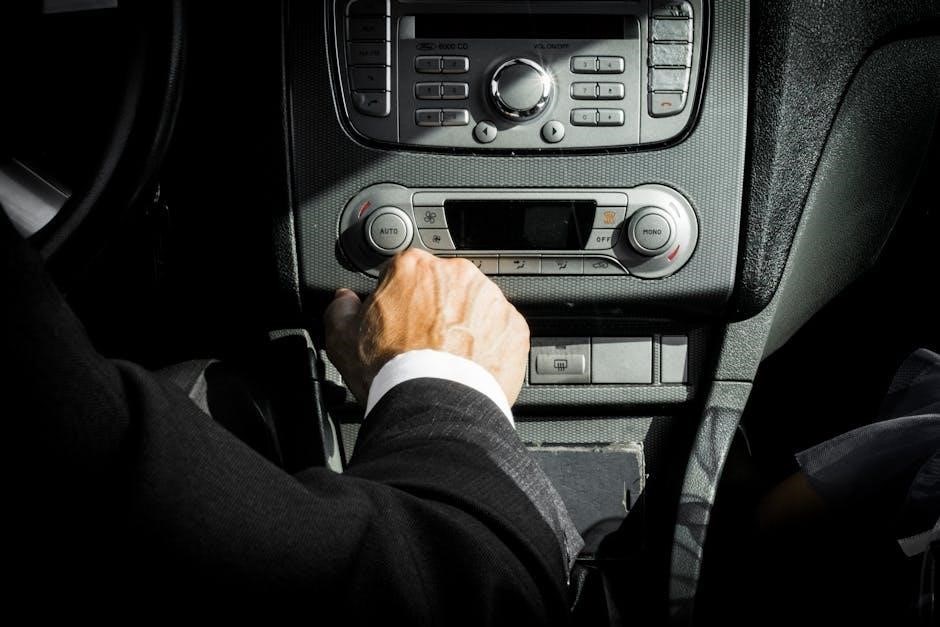manual car seat won’t move forward or back
Manual car seats can become stuck due to various reasons, causing inconvenience to drivers and passengers, requiring immediate attention to resolve the issue quickly and safely always.
Understanding the Problem
Manual car seats can experience issues that prevent them from moving forward or backward, which can be frustrating for drivers and passengers. The problem can arise due to various factors, including mechanical or electrical issues. It is essential to understand the root cause of the problem to resolve it effectively. By analyzing the symptoms and possible causes, individuals can take the necessary steps to fix the issue. The problem can be attributed to a faulty mechanism or an obstruction that prevents the seat from moving. Identifying the underlying cause is crucial to finding a solution. A thorough understanding of the problem will enable individuals to take the correct course of action to repair or replace the faulty component, ensuring the manual car seat functions correctly and safely. This understanding is vital to maintaining the overall comfort and convenience of the vehicle.
Common Causes of Stuck Seats
There are several common causes of stuck seats in manual car seats, including debris or obstructions in the mechanism. The seat tracks can become clogged with dirt, dust, or other particles, preventing the seat from moving. Additionally, the adjustment knob or lever can become stuck or jammed, making it difficult to adjust the seat. In some cases, the seat may be stuck due to a faulty or worn-out component, such as a broken spring or a damaged gear. These causes can be attributed to wear and tear, poor maintenance, or accidental damage. Understanding these common causes can help individuals identify and address the issue, ensuring the manual car seat functions smoothly and safely. Regular cleaning and maintenance can also help prevent these issues from occurring. By being aware of these causes, drivers can take preventive measures.

Diagnosing the Issue
Diagnosing the issue requires inspecting the seat and its components carefully always to determine the cause of the problem quickly and safely every time.
Checking for Obstructions
To check for obstructions, look under the seat for any objects that may be blocking its movement, such as coins, keys, or other small items.
Check the seat tracks for any debris or dust that may be causing the seat to become stuck.
Use a flashlight to inspect the area thoroughly and remove any obstructions found.
Also, check the seat adjustment mechanism for any blockages or damage.
If the seat is still stuck after removing any obstructions, try shaking the seat gently to dislodge any remaining debris.
This should help to resolve the issue and allow the seat to move freely once again, ensuring safe and comfortable driving conditions.
Regularly checking for obstructions can help to prevent the seat from becoming stuck in the future, reducing the risk of accidents and improving overall vehicle maintenance.
Verifying the Seat is Unlocked
To verify the seat is unlocked, locate the release lever and check its position, ensuring it is not stuck in the locked position.
Sometimes the lever can become jammed, preventing the seat from moving, so try wiggling it gently to free it.
If the lever is in the locked position, move it to the unlocked position and try adjusting the seat again.
It is also a good idea to consult the vehicle’s manual for specific instructions on unlocking the seat, as the process may vary depending on the make and model.
By verifying the seat is unlocked, you can quickly resolve the issue and adjust the seat to a comfortable position, improving your driving experience and reducing the risk of distraction while driving, which is essential for safe driving practices and overall road safety.

Possible Solutions
Manual car seat issues can be resolved with simple solutions and adjustments always quickly and safely every time.
Shaking the Seat
To resolve the issue of a manual car seat not moving forward or back, one possible solution is to shake the seat gently. This method can help dislodge any debris or obstruction that may be causing the seat to become stuck. By giving the seat a firm shake, the adjustment mechanism can be re-engaged, allowing the seat to move freely once again. It is essential to be careful when shaking the seat to avoid causing any damage to the surrounding components. The shaking motion can help to loosen any stuck parts, making it easier to adjust the seat to the desired position. This simple technique can be an effective way to resolve the issue without requiring any complex repairs or adjustments, and it can be done quickly and easily. The seat should be shaken gently but firmly to achieve the desired result.
Adjusting the Knob
Adjusting the knob is a crucial step in resolving the issue of a manual car seat not moving forward or back. The adjustment knob plays a significant role in controlling the seat’s movement, and it may be the cause of the problem. If the knob is turned all the way to one side, it can prevent the seat from moving in the other direction. By adjusting the knob to a neutral position, the seat may be able to move freely once again. It is essential to turn the knob gently and carefully to avoid causing any damage to the surrounding components. The knob should be adjusted slowly and deliberately to ensure that it is in the correct position. This simple adjustment can make a significant difference in resolving the issue and allowing the seat to move as desired. The correct adjustment of the knob is vital.

Electrical and Mechanical Issues
Electrical and mechanical issues can cause problems with manual car seats, requiring professional attention to resolve complex faults quickly and safely always within reason.
Motor Failure
A motor failure can be a significant issue, causing the manual car seat to malfunction, and it is essential to address this problem promptly to ensure safe driving conditions. The motor controls the movement of the seat, and when it fails, the seat may not move forward or backward. This issue can be caused by various factors, including wear and tear, electrical problems, or mechanical faults. It is crucial to identify the root cause of the motor failure to repair or replace it effectively. A professional mechanic can diagnose the issue and provide the necessary repairs to get the seat functioning correctly. Regular maintenance can help prevent motor failure, and it is vital to check the seat’s mechanical components regularly to ensure they are in good working condition, thus preventing potential accidents and ensuring driver safety always.
System Failure
A system failure can be a complex issue, causing the manual car seat to malfunction, and it may require professional assistance to resolve. The system consists of various components, including electrical and mechanical parts, that work together to control the seat’s movement. When the system fails, the seat may not move forward or backward, or it may become stuck in a particular position. The failure can be caused by a fault in the electrical circuit, a malfunctioning sensor, or a mechanical component failure. It is essential to diagnose the issue correctly to repair or replace the faulty component, and a professional mechanic can help identify the root cause of the problem. Regular maintenance and checks can help prevent system failure, ensuring the seat functions correctly and safely, and preventing potential accidents, thus providing a safe driving experience always with proper functioning seats.

Power Seat Issues
Power seat problems can occur due to electrical faults, requiring fuse box checks always and quickly to resolve issues safely.
Checking the Fuse Box
To troubleshoot power seat issues, checking the fuse box is a crucial step, as a blown fuse can prevent the seat from moving forward or backward.
The fuse box is usually located under the dashboard or in the glove compartment, and it contains a series of fuses that control various electrical systems in the vehicle.
By consulting the vehicle’s manual or a diagram, you can identify the fuse that corresponds to the power seat and check if it has blown.
If the fuse has blown, replacing it with a new one of the same amperage rating can resolve the issue.
It is essential to be careful when handling electrical components to avoid any damage or injury;
Checking the fuse box is a simple and straightforward process that can help you identify and fix the problem quickly and efficiently, getting your power seat working again.

